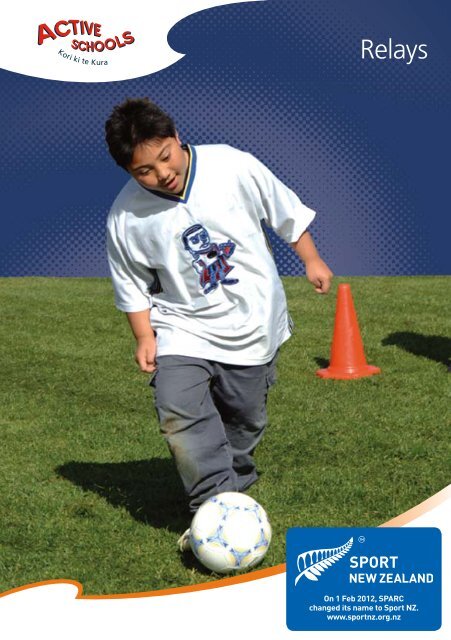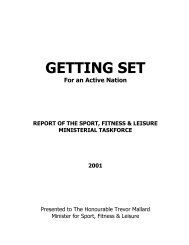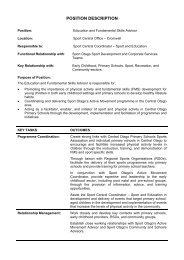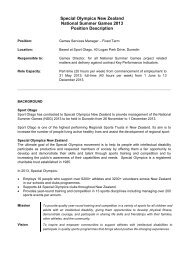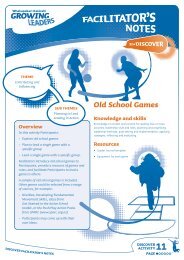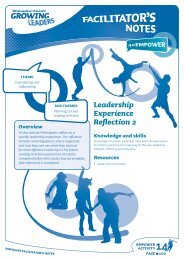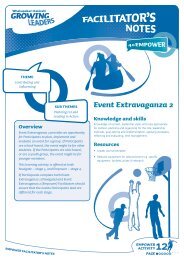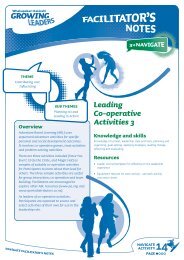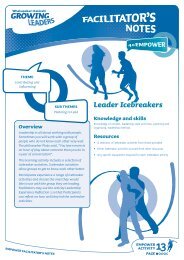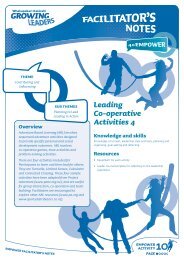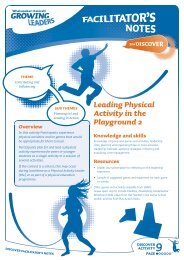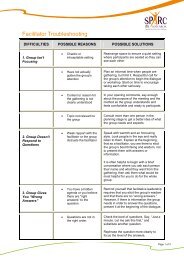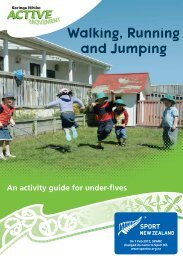Kiwidex Relays - Sport New Zealand
Kiwidex Relays - Sport New Zealand
Kiwidex Relays - Sport New Zealand
Create successful ePaper yourself
Turn your PDF publications into a flip-book with our unique Google optimized e-Paper software.
KIWIDEX<br />
PARTNER ACTIVITIES<br />
97<br />
<strong>Relays</strong><br />
On 1 Feb 2012, SPARC<br />
changed its name to <strong>Sport</strong> NZ.<br />
www.sportnz.org.nz
98<br />
Section Contents<br />
Organisation Hints 99<br />
There and Back <strong>Relays</strong> 100<br />
There and Back <strong>Relays</strong> with Balls and Hoops 103<br />
There and Stay <strong>Relays</strong> 105<br />
Carry Then Throw 106<br />
Half and Half <strong>Relays</strong> 107<br />
Spread Out <strong>Relays</strong> (Zigzag) 109<br />
Meet in the Middle 111<br />
Over the Legs Relay 112<br />
Chase the Tail 113<br />
Paired Relay 114<br />
Non-Stop Relay 115<br />
Tunnel Relay 116<br />
Exchange Relay 118<br />
Circle the Bases 119<br />
Wheel Relay 121<br />
Fireman’s Bucket (Rescue Relay) 122<br />
Animal Antics Relay 123
KIWIDEX<br />
RELAYS<br />
99<br />
Organisation Hints<br />
<strong>Relays</strong> are an exciting, enjoyable activity for the daily physical activity<br />
programme. Large numbers of children can be easily organised and kept<br />
active in a relatively small space, either inside or outside.<br />
There are endless possible combinations of activities for relays, either<br />
without gear or with simple equipment. Use the ideas in the manual to<br />
create your own relay sequences.<br />
• Keep relay teams small – 4 should be the maximum.<br />
• Have teams working across the area i.e. use the width.<br />
• Have a marker cone, hoop, peg or line to show the boundary.<br />
• Keep the distance travelled short e.g. one-third of a netball court,<br />
or the width of a netball court, approximately 5-10 metres (use<br />
the shorter distance for juniors).<br />
• Give clear directions before you begin a relay e.g. begin on the<br />
word “Go”, run to the cone, run around the cone, skip back<br />
to the team, run around the back of the team and tag the next<br />
runner. Everyone in the team has 2 turns, marching on the spot<br />
when finished.<br />
Explain:<br />
1. How the relay will start.<br />
2. What to do on the way to the boundary e.g. run, hop.<br />
3. What to do at the turn or changeover point.<br />
4. What to do travelling back.<br />
5. What to do when runner returns to team.<br />
6. What the team should be doing when finished.
100<br />
There and Back <strong>Relays</strong><br />
Most of the relays can be performed in a hall, on grass or on a hard surface<br />
– lines marked on a netball or padder tennis court are an advantage when<br />
organising relays. If no lines are available use cones, hoops, ropes or pegs<br />
to mark the starting line and the boundary line (this is the line the children<br />
must run to).<br />
Equipment<br />
Cones or hoops for markers,<br />
1 for each pair.<br />
Area<br />
Hall, grass, hard surface – some kind of marking line is useful for starting<br />
if not using cones or hoops. Distance from starting line to boundary line<br />
should be 8-10 metres, shorter distance for juniors.<br />
Formation<br />
Children in 2s, 3s, or 4s lined up one behind the other at the starting line,<br />
facing the boundary cone or mark.<br />
Instructions<br />
• Number 1 travels to the boundary in the way<br />
designated by teacher – around the marker and back<br />
to team or partner – tags the next person in line who<br />
repeats the sequence.<br />
•<br />
•<br />
Number 1 goes to the back of the line.<br />
Repeat until whole team has had a turn at going<br />
“There and Back”.
KIWIDEX<br />
RELAYS<br />
101<br />
Variation<br />
1. Select 3 activities – 1 from each column – activities can be mixed<br />
and matched.<br />
On the way there At the boundary On the way back<br />
• Run<br />
• Run around cone • Run<br />
• Skip<br />
• Jump forward and<br />
back 3 times<br />
• Run backwards<br />
• Slip step<br />
• Do 5 astride jumps • Slip step (other leg<br />
leads)<br />
• Hop on left foot • Jump over the cone • Hop right foot<br />
• Gallop<br />
• Run around cone • Wooden soldier run<br />
3 times<br />
• Long, low strides • 5 bounces on the spot • High knee running<br />
• Run with arms<br />
• 5 hops on left foot, • Run with arms out<br />
above head<br />
5 hops on right foot to side<br />
Teaching Points<br />
• Repeat each relay sequence twice through the team, especially if<br />
the combinations are complicated.<br />
• Have the children work out some other activities to do “at the<br />
boundary” or on the way “There and Back”.
102<br />
There and Back <strong>Relays</strong>
KIWIDEX<br />
RELAYS<br />
103<br />
There and Back <strong>Relays</strong> with Balls and Hoops<br />
Equipment<br />
One large ball, 1 hoop per team.<br />
Area<br />
Hall, grass, hard surface (an area the<br />
size of a netball court), starting line or<br />
markers and boundary lines or markers.<br />
Width of area 5-15 metres – use<br />
shorter distance for juniors.<br />
Formation<br />
Children in 2s, 3s or 4s lined up one behind the other at the starting line<br />
facing the hoops. Select 3 activities, 1 from each column – activities can be<br />
mixed and matched.<br />
Balls<br />
5 – 15m<br />
On the way there At the hoop On the way back<br />
• Run, holding ball<br />
above head<br />
• Bounce ball 5 times in<br />
the hoop<br />
• Run, holding ball<br />
behind back<br />
• Run or jump ball • Drop ball to land • Foot tap the ball<br />
between legs<br />
• Run, balancing ball on • Throw ball in air and • Run with ball balanced<br />
backs of hands<br />
catch it<br />
on palms<br />
• Run, bouncing ball with • Walk around hoop • Run, bouncing left hand<br />
right hand<br />
bouncing ball in hoop<br />
• Ball on ground – foot • Put ball into hoop • Run backwards dragging<br />
dribble to hoop<br />
with feet<br />
ball back with feet<br />
Hoops
104<br />
On the way there At the hoop On the way back<br />
• Bat ball along ground<br />
with hand<br />
• Foot tap ball<br />
around hoop<br />
• Pick ball up between<br />
elbows and run back<br />
• Bowl the ball<br />
towards hoop<br />
• Stand in the hoop and<br />
throw ball<br />
• Run back, stop a<br />
short distance from<br />
team, throw ball to<br />
next person<br />
• Slip step sideways, • Pass ball around waist • Bowl ball to team, run<br />
bouncing ball<br />
3 times<br />
and scoop up and throw<br />
it to next person<br />
• Run, throwing ball<br />
upwards and catching it<br />
• Stand in hoop, legs<br />
apart and pass ball in<br />
and around legs in figure<br />
8 shape<br />
• Run back, stop a short<br />
distance from team and<br />
bounce to next person<br />
Teaching Point<br />
• Other equipment can be used in a similar way – frisbees,<br />
tenniquoits, skipping ropes, padder tennis bats, small balls.
KIWIDEX<br />
RELAYS<br />
105<br />
There and Stay <strong>Relays</strong><br />
Equipment<br />
None.<br />
Area<br />
Hall, grass, hard surface<br />
– lines or marks for starting<br />
positions and boundary lines – lines 5-15 metres apart.<br />
Formation<br />
Children in teams of 2, 3 or 4 line up one behind the other.<br />
Instruction<br />
• Number 1 moves to the boundary line and stays there<br />
then calls “Go”.<br />
• On “Go” Number 2 moves across and calls “Go”.<br />
• Repeat until all team members have moved.<br />
• The sequence can be repeated until all children are<br />
back in their original positions.<br />
Variations<br />
1. Follow the Leader<br />
– First person decides how the team should move across.<br />
– All other team members copy the movement as they move.<br />
– Second person becomes leader.<br />
– Repeat until everyone has been a leader.<br />
2. Stay and Do<br />
– First person runs across to boundary and performs an activity<br />
specified by teacher e.g. 5 astride jumps then calls “Go”.<br />
– Repeat until everyone has a turn.<br />
Teaching Point<br />
• Vary the type of movement to include skipping, hopping etc.
106<br />
Carry Then Throw<br />
Equipment<br />
One ball per team<br />
(large or small size).<br />
Area<br />
Hall, grass, hard surface, a<br />
starting line and boundary line<br />
3-5 metres apart.<br />
Starting Line<br />
Carry Ball<br />
Throw Ball<br />
Boundary Line<br />
Formation<br />
Children in teams of 2, 3 or 4 lined up one behind the other at the starting<br />
line – facing the boundary line or mark. First person has the ball.<br />
Instructions<br />
• First child runs with the ball to the boundary line,<br />
turns and throws to Number 2 then returns to the<br />
starting line.<br />
• Number 2 catches the ball and runs with it to the<br />
boundary line – turns and throws to Number 3.<br />
• Repeat this sequence several times.<br />
Variations<br />
1. Bounce dribble to line, turn and throw.<br />
2. Foot dribble to line, turn and throw.<br />
3. Run with the ball between the knees – turn and throw.<br />
4. Return the ball by bowling it along the ground.<br />
Teaching Point<br />
• For juniors keep distances short – encourage accuracy with<br />
throwing and catching.
KIWIDEX<br />
RELAYS<br />
107<br />
Half and Half <strong>Relays</strong><br />
Equipment<br />
Marker cones or pegs<br />
if there are no lines<br />
on surface.<br />
Area<br />
Hall, grass, hard surface, a starting line and a boundary line<br />
3-8 metres apart.<br />
Formation<br />
Children in 4s – 2 children at the starting line and 2 children at the boundary<br />
line opposite – facing each other.<br />
Instructions<br />
• Number 1 runs to Number 2 and tags him and<br />
stays there.<br />
• Number 2 runs to Number 3 and tags him and<br />
stays there.<br />
• Number 3 runs to Number 4 and tags him and<br />
stays there.<br />
• Repeat until all children are back where they started.
108<br />
Variations<br />
1. Round the Back – Formation as above.<br />
– Number 1 runs across the area and around the back of<br />
Number 2 and Number 4, then tags Number 2, who runs<br />
across and around the back of Number 3 and tags him.<br />
Repeat several times.<br />
2. Run and Copy – Formation as above.<br />
– Number 1 runs across and stops in front of Number 2 and begins<br />
doing an activity on the spot. Number 2 copies the activity e.g.<br />
double hops and together they do 10-15 repetitions. Number 1<br />
stays there and Number 2 runs across to Number 3 and performs<br />
an “on the spot” activity which Number 3 copies.<br />
– Repeat until everyone is back in their starting positions.<br />
Teaching Point<br />
• Encourage original activities on the spot.
KIWIDEX<br />
RELAYS<br />
109<br />
Spread Out <strong>Relays</strong> (Zigzag)<br />
Equipment<br />
Cones to mark the start and<br />
finish of the relay course.<br />
Area<br />
Hall, grass, hard surface<br />
– total length of relay<br />
course depends on how far apart the children stand.<br />
Formation<br />
Width of a netball court works well, teams of 4-5 children, with the team<br />
members evenly spaced along the whole length of the relay circuit.<br />
Instructions<br />
• The back person, Number 1, begins and runs forward<br />
zigzagging around other children – around front<br />
marker then round the back marker and back to their<br />
place. Calls “Go” – or tags Number 2.<br />
• Number 2 zigzags forward – to front marker –<br />
alongside the team to back marker then zigzags back<br />
to place and calls “Go” to Number 3.<br />
Variations<br />
1. Vary the movement e.g. skipping, galloping.<br />
2. Vary the distance between children.<br />
Teaching Point<br />
• Encourage good control when zigzagging.
110<br />
Spread out relays
KIWIDEX<br />
RELAYS<br />
111<br />
Meet in the Middle<br />
Equipment<br />
Marker cones or pegs<br />
if there are no lines<br />
on surface.<br />
31 24<br />
Starting Line<br />
Meeting Line<br />
Boundary Line<br />
Area<br />
Hall, grass, hard<br />
surface (area about<br />
size of netball court),<br />
starting line, a meeting line and a boundary line.<br />
Formation<br />
Children in 4s. Begin with half the children on the boundary line and half on<br />
the starting line – 1 and 2 are partners, 3 and 4 are partners; children face in<br />
towards the meeting line.<br />
Instructions<br />
• On “Go”, Numbers 1 and 2 run in to the meeting line<br />
and hold both hands high and clap partners’ hands<br />
with a “High 10”.<br />
– They both turn and return to their places and give<br />
the waiting team members a High 10.<br />
– Numbers 3 and 4 run in to meeting line, give each<br />
other High 10 and run back and give 1 and 2<br />
a High 10.<br />
Variations<br />
1. Give partners a “High 10” and a “Low 10”<br />
2. Change the type of movement to the meeting line e.g. skip, hop<br />
3. Change the activity at the meeting line e.g. skipping in a circle with<br />
arms linked, hands joined and sawing movement.
112<br />
Over the Legs Relay<br />
Equipment<br />
Two marker cones – for start and<br />
finish of relay course.<br />
Area<br />
Hall, grass, hard surface – total length<br />
of course 8-20 metres – shorter distance for juniors.<br />
Formation<br />
Teams of 4-6 children – team members evenly spaced along the course,<br />
length of the relay from 1 to 3 metres apart. All children sit down side-on to<br />
the direction of travel.<br />
Instruction<br />
• Back person begins on “Go”. She stands and runs<br />
forward jumping over the legs of all team members,<br />
and she runs around the cone at the front of the<br />
team, alongside team and around marker and back<br />
to her place.<br />
• Once seated, Number 1 calls “Go” to Number 2, who<br />
jumps over legs on the way forward etc.<br />
• Repeat the sequence until everyone has had a turn.<br />
Variations – Leap Frog Relay<br />
1. Formation as above – but team members crouch down with heads<br />
tucked under.<br />
2. Back person begins and leap frogs, or steps, over team members as<br />
they make their way to the front.<br />
3. Repeat sequence as above.<br />
Teaching Point<br />
• Care is needed when working on hard ground.
KIWIDEX<br />
RELAYS<br />
113<br />
Chase the Tail<br />
Equipment<br />
Marker cones to<br />
show front and back<br />
boundaries.<br />
Area<br />
Hall, grass, hard surface.<br />
Formation<br />
Teams of 4-6 lined up in single file all facing the same way – marker cones<br />
or lines as shown.<br />
Instruction<br />
• Number 4 starts and runs forwards and around front<br />
marker, alongside the team and around the back cone<br />
and back to the front cone again.<br />
• As Number 4 passes Number 1 for the second time the<br />
whole team follows around the front cone down and<br />
around the back cone and back to their places.<br />
• Number 3 is now the back person and becomes the<br />
new runner.<br />
• Repeat until everyone has had a turn.<br />
Variation<br />
1. Change the activity to skipping, galloping etc.<br />
Teaching Points<br />
• Demonstrate this relay with 1 team under close direction<br />
from teacher.<br />
• Each runner does 2 circuits – 1 on his own and 1 with the team<br />
chasing him.
114<br />
Paired Relay<br />
Equipment<br />
Cones, lines markers to show<br />
starting line and boundary line.<br />
Area<br />
Hall, grass, hard surface – 5-8<br />
metres between start and boundary.<br />
Formation<br />
Children in 4s (two pairs per group). Pairs stand one behind the other behind<br />
the starting boundary line, hands joined.<br />
Instruction<br />
• First pair with hands joined runs to the line and back.<br />
•<br />
•<br />
•<br />
•<br />
Second pair repeats.<br />
First pair runs backwards there and back; second pair<br />
repeats.<br />
Continue – with teacher calling a different type of<br />
movement for each lap.<br />
Hands remain linked throughout.<br />
Variations<br />
1. Skipping, hopping, galloping, sideways slip step – both hands joined.<br />
Back to back – elbows linked – 1 moves forward, 1 backwards. Back<br />
to back – elbows linked – side-on – both move sideways.<br />
2. Ask each pair to find a new way of moving – with 1 hand linked.<br />
Teaching Point<br />
• Stress safety when the children are creating their own moves,<br />
especially with carrying activities.
KIWIDEX<br />
RELAYS<br />
115<br />
Non-Stop Relay<br />
Equipment<br />
Starting Line<br />
Middle Line<br />
Boundary Line<br />
Marker cones, pegs or lines.<br />
Area<br />
Hall, grass, hard surface,<br />
A<br />
1 2 3 4<br />
B<br />
set out as in diagram.<br />
Formation<br />
Children in 4s lined up at a central point.<br />
5 –8m 5 –8m<br />
Instruction<br />
• On “Go” Numbers 1 and 4 start together, 1 runs to<br />
line A and back to team, 4 runs to line B and back<br />
to team.<br />
• When 1 and 4 return to team they “touch off”<br />
Numbers 2 and 3.<br />
• 2 runs to line A, 3 runs to line B.<br />
• When 2 and 3 return they both “touch off”<br />
1 and 4 again.<br />
• Repeat several times.<br />
Variations<br />
1. Change the activity to the boundary lines e.g. hop, skip etc.<br />
2. Vary the distance to the boundary lines.<br />
3. As Numbers 1 and 4 return to the team have them skip a circle with<br />
Numbers 2 and 3 before they begin their run.<br />
4. An activity can be added at the boundary line e.g. astride jumps,<br />
side-to-side jumps.<br />
Teaching Point<br />
• The two children waiting at the mid-line should keep moving on<br />
the spot, especially on cold days.
116<br />
Tunnel Relay<br />
Equipment<br />
Cones to mark front and back of<br />
relay course.<br />
Area<br />
Hall, grass, hard surface.<br />
Formation<br />
Children in groups of 6-8. Within each group children<br />
pair up and stand with partners facing each other and arms stretched up to<br />
form arches – partners 1-1.5 metres apart.<br />
Instructions<br />
• On teacher command first pair moves to the front<br />
marker separately and turn outwards and run down<br />
to the back markers.<br />
• Partners meet – join hands and move through the<br />
tunnel and back to their places.<br />
• Second pair begins moving as soon as the first pair<br />
returns to their places – they run under the arch made<br />
by 1st pair, around the cones etc.<br />
• Repeat until everyone has had a turn.<br />
Variations – Skin the Snake Relay<br />
1. Formation as above – first pair turns inwards and moves through the<br />
tunnel to the end of the line where they line up. Second pair does<br />
the same – the remainder of the team must keep moving forwards as<br />
each pair moves to the back of the team.<br />
2. This tunnel relay can be done with the whole class.<br />
Teaching Point<br />
• Ensure that the children keep moving forwards in “Skin the<br />
Snake” relay.
KIWIDEX<br />
RELAYS<br />
117<br />
Tunnel Relay
118<br />
Exchange Relay<br />
Equipment<br />
3<br />
1<br />
2<br />
4<br />
Two bean bag bands or batons per<br />
team, cones or markers to mark start<br />
and boundary.<br />
Area<br />
Hall, grass, hard surface – painted<br />
lines are an advantage.<br />
A<br />
C<br />
B<br />
Formation<br />
Teams of 4 with 2 children on each boundary line standing opposite each<br />
other and facing into the middle line.<br />
Instructions<br />
• Number 1 and Number 2 have a baton (or<br />
similar) each.<br />
• On “Go”, Numbers 1 and 2 run in to meet at C – they<br />
exchange batons, turn and run back to Numbers 3<br />
and 4 and hand them the batons.<br />
• Numbers 3 and 4 repeat the sequence.<br />
• Repeat several times.<br />
Variations<br />
1. Vary the type of activity – galloping, slipping, hopping.<br />
2. When children exchange batons have them simultaneously throw to<br />
each other (as in Màori stick games).<br />
Teaching Point<br />
• Although daily physical activity is a non-competitive activity it<br />
sometimes adds interest to an activity to add an element of<br />
competition – see which team can complete 10 exchanges first<br />
e.g. which team can complete 10 exchanges without dropping<br />
the baton.
KIWIDEX<br />
RELAYS<br />
119<br />
Circle the Bases<br />
Equipment<br />
Four cones to mark corners (e.g. use lines).<br />
Area<br />
Hall, grass, hard surface – an area 20-25<br />
metres square.<br />
Formation<br />
Groups of 4 children set out as shown in<br />
diagram. If additional teams are required they<br />
can be placed at the *.<br />
Instructions<br />
• On “Go”, first runner for each team runs in a<br />
clockwise direction around the perimeters and<br />
returns to her team.<br />
• When tagged by Number 1 the 2s repeat the sequence<br />
– Number 1 moves to the back until each child has had<br />
a turn.<br />
• Waiting team members could jog or bounce on the<br />
spot or perform an activity directed by the teacher.<br />
Variations<br />
1. Change the activity around the perimeter – marching,<br />
skipping, walking.<br />
2. Two children from each team run at once.<br />
Teaching Point<br />
• This relay can be adapted for ball skills – the runners can bounce,<br />
dribble or foot dribble a ball around the perimeter.
120<br />
Circle the Bases
KIWIDEX<br />
RELAYS<br />
121<br />
Wheel Relay<br />
Equipment<br />
Two cones per team, 1 baton or<br />
band per team.<br />
Area<br />
Grass, hard surface.<br />
Formation<br />
Groups of 3 or 4 children lined up one behind<br />
the other like the spokes of a wheel.<br />
Instructions<br />
• A cone is placed at each end of the team.<br />
• First runner, nearest the centre, has a baton –<br />
on “Go”, Number 1 runs around the team and in<br />
a clockwise direction around the outside of all<br />
other teams.<br />
• When 1 returns to team line they line up at outer end<br />
and pass the baton down the line of team members<br />
to the next runner, who repeats the sequence.<br />
• Repeat several times.<br />
Variations<br />
1. Use a ball instead of baton. Runner carries, dribbles or kick taps it as<br />
she runs.<br />
2. First runner zigzags in and out of team as she begins her run.<br />
3. Two children from each team run at the same time.<br />
Teaching Point<br />
• Keep the teams small – maximum of 4. If classes are large increase<br />
the number of teams and make the circle larger.
122<br />
Fireman’s Bucket (Rescue Relay)<br />
Equipment<br />
Cones, hoops or lines<br />
to use as markers.<br />
Area<br />
Hall, grass, hard surface<br />
– running distance 5-6 metres.<br />
Formation<br />
Children in groups of 3 or 4 lined up one behind the other – all facing the<br />
boundary line.<br />
Instructions<br />
• Number 1 is the “Fireman”. He takes Number 2’s hand<br />
and runs with him to the boundary line and leaves<br />
him there and runs back to the team.<br />
• Number 1 now takes Number 3 over to the other side,<br />
then Number 4 – all team members are now opposite<br />
where they started.<br />
• Number 2 now takes each person in turn back to the<br />
other side.<br />
• Repeat this sequence until all members have had a<br />
turn at being fireman.<br />
Variations<br />
1. Change the activity to skipping, galloping etc.<br />
2. Increase the running distance.
KIWIDEX<br />
RELAYS<br />
123<br />
Animal Antics Relay<br />
Equipment<br />
Cones or marking pegs for<br />
boundaries.<br />
Area<br />
Hall, grass, hard surface– running<br />
distance 3-5 metres.<br />
Formation<br />
Children in pairs – lined up one behind the other facing a boundary line<br />
about 5 metres away.<br />
Instructions<br />
• Children take turns to move to the boundary line<br />
and back imitating the movements of a well-known<br />
animal nominated by the teacher.<br />
• Kangaroos – hold hands together at chest height and<br />
jump with both feet together.<br />
• Elephants – lean forward with bent knees arms<br />
straight and hands clasped – swing arms from side<br />
to side.<br />
• Suggested animals: Prancing horses, hawks or eagles,<br />
stalking cats, caterpillars, galloping horses, crabs.<br />
Variations<br />
1. Have children think of their own animals to copy.<br />
2. Children could move freely about the area imitating an animal – other<br />
children could try to guess what each animal is.<br />
Teaching Point<br />
• Encourage originality – allow children to develop their ideas<br />
– children work in pairs to produce the movement pattern of<br />
1 animal.
124<br />
Animal Antics Relay


